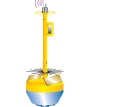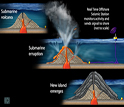News Release 07-056
Real-Time Seismic Monitor Installed on Growing Underwater Volcano
First use for underwater radio telemetry

Kick'em Jenny and her new seismic gear are located just off the coast of the island of Grenada.
May 10, 2007
This material is available primarily for archival purposes. Telephone numbers or other contact information may be out of date; please see current contact information at media contacts.
Kick'em Jenny is its name, and for oceanographers working in the southeastern Caribbean Sea, this undersea volcano has been a handful.
Now, a team of marine scientists funded by the National Science Foundation (NSF) and affiliated with the Woods Hole Oceanographic Institution (WHOI) may have figured out how to tame it. This week, the researchers will begin using radio telemetry to monitor the rumblings of Kick'em Jenny from a real-time seismic monitoring device installed on the volcano.
The new technology will improve the ability of natural hazards managers to protect residents from volcanic eruptions and tsunamis, said Alex Isern, program director in NSF's Division of Ocean Sciences. "Basic oceanographic research leads to technological advances that directly benefit society--like detecting hazards--in time to make a difference," said Isern.
Located just off the north coast of the island nation of Grenada, Kick 'em Jenny is a "natural laboratory"--a submarine volcano that will eventually emerge from beneath the sea to form a new volcanic island. It is the only "live" submarine volcano in the West Indies, and has erupted at least 12 times since 1939. The last major eruption occurred in 2001.
Part of a project to develop new technology for earthquake monitoring in coastal areas, the seismic station, called a Real Time Offshore Seismic Station (RTOSS), uses an ocean-bottom seismometer deployed directly on the volcano. RTOSS allows seismic data to be transmitted by high-frequency radio to a land-based observatory in a nearby village. The data will reach the shore within milliseconds of being collected.
"This is the first time that radio telemetry has been used to transmit data from an underwater seismic monitoring station," said Rob Reves-Sohn, a WHOI geologist and RTOSS project leader.
Scientists will be able to observe the "inhaling and exhaling" of the volcano as it draws in and expels seawater, magma and superheated fluids.
The research team is coordinating its efforts with the National Disaster Management Agency in Grenada and the Seismic Unit of the University of the West Indies. The data will be incorporated into the regional monitoring network in the Lesser Antilles.
Funding for the project is also being provided by WHOI and the U.S. Geological Survey.
-NSF-
-
A real-time seismic monitoring instrument will track Kick'em Jenny's rumbles.
Credit and Larger Version -
Over time, layers of lava from an underwater volcano can build up and emerge as an island.
Credit and Larger Version
Media Contacts
Cheryl Dybas, NSF, (703) 292-7734, email: cdybas@nsf.gov
Stephanie Murphy, WHOI, (508) 289-3340, email: samurphy@whoi.edu
The U.S. National Science Foundation propels the nation forward by advancing fundamental research in all fields of science and engineering. NSF supports research and people by providing facilities, instruments and funding to support their ingenuity and sustain the U.S. as a global leader in research and innovation. With a fiscal year 2023 budget of $9.5 billion, NSF funds reach all 50 states through grants to nearly 2,000 colleges, universities and institutions. Each year, NSF receives more than 40,000 competitive proposals and makes about 11,000 new awards. Those awards include support for cooperative research with industry, Arctic and Antarctic research and operations, and U.S. participation in international scientific efforts.
Connect with us online
NSF website: nsf.gov
NSF News: nsf.gov/news
For News Media: nsf.gov/news/newsroom
Statistics: nsf.gov/statistics/
Awards database: nsf.gov/awardsearch/
Follow us on social
Twitter: twitter.com/NSF
Facebook: facebook.com/US.NSF
Instagram: instagram.com/nsfgov




